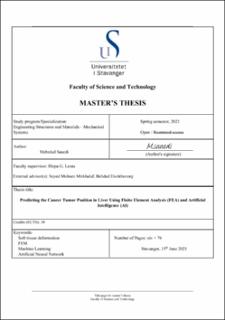| dc.description.abstract | The computational power and advantages of the Finite Element Method (FEM) are noticeable.
When dealing with high nonlinearity of the materials and geometrical complexity, FEM is a powerful solution, depending on the correct definition of the problem. The availability of this method has benefited many engineering areas. In the field of biomechanics and, more specifically, in Computer-Assisted Surgery,
FEM is even more appreciated. This approach, however, comes at a high computational cost. Thus, a significant delay in the response impedes its implementation for real-time applications in clinical practices, even by using parallelization or utilizing Graphics Processing Unit (GPU). This is where an alternative approach is needed to accelerate FEM- based simulations to provide the desired outputs and minimizing the time lag, preventing using FEM during intra-operative applications.
A novel technique that may help to overcome the obstacles mentioned above and improve the response time is the field of Machine Learning (ML). In particular, the Artificial Neural Network (ANN), as a subset of ML, has demonstrated high potentials in computer vision and pattern recognition, whose implementation can be extended to replace a FEM model once it has been trained with sufficient inputs.
In this work, a FEM-ML framework is established to drastically increase the response time for predicting tumor and internal structures’ locations in the human liver for surgical applications by using ANN. This technique takes advantage of the FEM results to train
a model capable of capturing large deformations of liver tissue during the surgical intervention while reporting back the nodal locations of the components with high accuracy and efficiency. For doing so, a biomechanical model of the liver, accounting for the effect of the stiffness of blood vessels, is developed, and multiple simulations with random nodal loads on the surface of the liver are conducted in the commercial software Abaqus to produce the input required for the ANN. The ANN then predicts the nodes’ coordinates resulting from the applied forces that can be used to reconstruct the deformed model of
the organ. | |
